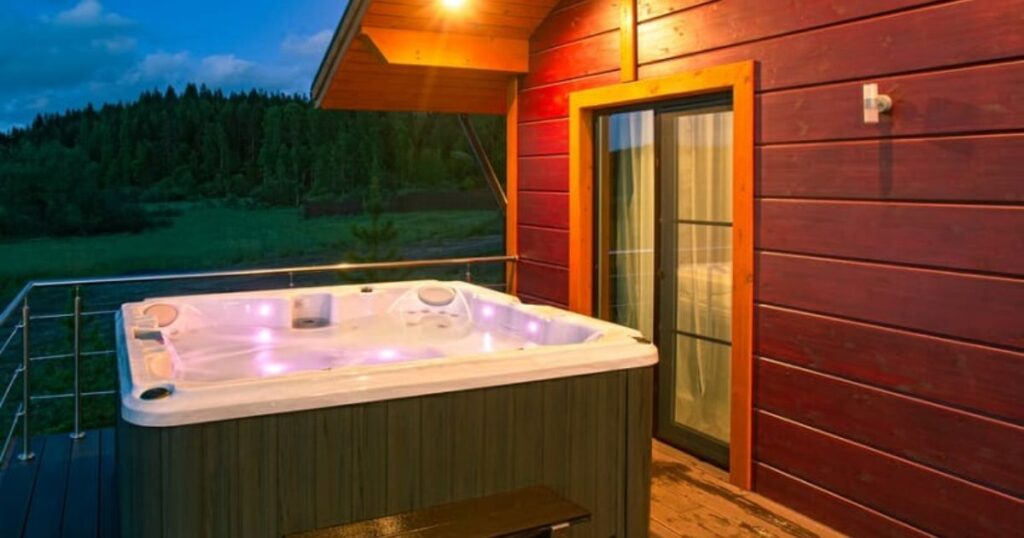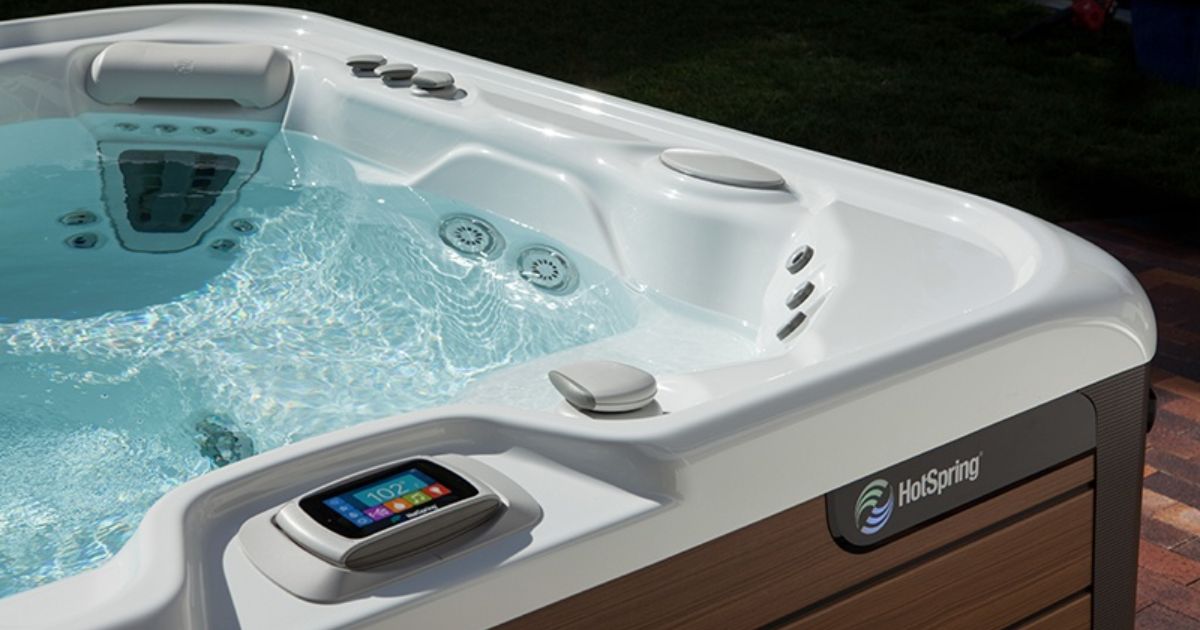Have you ever imagined soaking in a warm, bubbling hot tub, surrounded by soothing jets and the tranquil sounds of water? It’s a tempting thought, but many potential hot tub owners wonder about the impact on their energy bills.
Fear not, dear reader, for in this article, we’ll dive deep into the fascinating world of hot tub power consumption, exploring the various factors that affect energy utilization and providing practical tips to help you make an informed decision.
A Quick Intro to Hot Tub Electricity Usage

Contrary to popular belief, there’s no one-size-fits-all answer to the question “How much power does a hot tub use?” The electricity consumption of a hot tub can vary significantly based on several factors, including the size of the tub, its features, how often you use it, and the kWh rate in your local area.
Let’s consider a real-life example: Imagine two neighbors, John and Jane, both own hot tubs. John has a compact, basic model that he uses occasionally, while Jane has a larger hot tub with massaging jets, built-in speakers, and other fancy features, which she uses daily. It’s clear that Jane’s power usage will be higher than John’s due to the size and features of her tub.
Understanding the Power Guzzlers
When it comes to hot tub electricity consumption, two components stand out as the main power guzzlers: the heater and the pump. The heater is responsible for maintaining the water temperature, while the pump circulates the water, ensuring it remains clean and filtered.
Hot tub heaters typically come in two varieties: 120V and 240V. A 120V heater draws around 1,500 watts, while a 240V heater uses approximately 6,000 watts. To estimate your monthly electricity expenses, you can use the following formula:
(Heater wattage / 1000) x usage hours = kWh per month
Let’s apply this formula to a real-life scenario: Imagine you have a hot tub with a 240V heater with a wattage of 7,500, and you use it for about 25 hours a month. Your monthly electricity consumption would be:
(7,500 / 1,000) x 25 = 187.5 kWh per month
To find out how much your monthly expenses would increase, multiply the monthly consumption by the average kWh rate where you live. If the average rate is $0.10 per kWh, your monthly power bill would increase by $18.75 for that particular month.
| Hot Tub Usage | Heater Wattage | Usage Hours | kWh per Month | Cost (at $0.10/kWh) |
| Example | 7,500 | 25 | 187.5 | $18.75 |
Potential Energy Spikes
It’s important to note that these are just estimates, as there could be energy spikes during maintenance or when you first turn on the hot tub for the day. These spikes can increase your power consumption beyond the estimated figures.
Read More: Can I Put A Hot Tub In The Garage?
An Energy-Efficient Hot Tub Is a Smart Investment
Investing in an energy-efficient hot tub is a wise choice if you’re looking to minimize power usage without sacrificing features or performance. These models are designed with quality foam insulation that locks in heat, allowing the hot tub to maintain the optimal temperature without consuming excessive amounts of electricity.
Look for hot tubs with efficient filtration systems that can filter water quickly using low-amperage pumps. A high-quality cover is also crucial, as it will further reduce heat loss. A 3-4 inch hard, tapered cover with insulated bumpers provides superior insulation, ensuring that the other hot tub components don’t have to work as hard to keep the water warm.
Here are some tips to help you choose an energy-efficient hot tub:
- Look for models with high-quality foam insulation
- Prioritize efficient filtration systems with low-amperage pumps
- Choose hot tubs with hard, tapered covers with insulated bumpers
- Consider models with energy-saving features like heat pumps or circulation pumps
By investing in an energy-conserving hot tub, you can enjoy the benefits of hydrotherapy while minimizing the impact on your energy bills.
How Much Electricity Does a Hot Tub Use Per Month? A Closer Look
As we’ve established, the heater and pump are the primary energy consumers in a hot tub. To reiterate, a hot tub with a 120V heater will consume around 3,000 watts when in use, while a tub with a 240V heater will consume approximately 7,500 watts. The actual power consumption can be influenced by several additional factors:
- Tub size: The larger the hot tub, the more water it needs to heat, resulting in higher electricity expenses.
- Temperature settings: The higher the temperature you set, the more energy will be required to maintain it.
- Outdoor conditions: Factors like air temperature, wind speed, and humidity can impact heat loss, leading to increased power usage.
- Insulation quality: High-quality insulation and covers can significantly reduce heat loss, resulting in lower electricity consumption.
Let’s consider a case study to illustrate the impact of these factors. Imagine two identical hot tubs, both with 240V heaters, but one is located in a warm, sheltered area, and the other is exposed to colder temperatures and wind. The hot tub in the colder, windier location will likely consume more energy to maintain the same water temperature due to increased heat loss.
Consider All the Costs: Beyond Electricity
While electricity expenses are a significant part of hot tub ownership, it’s essential to consider the ongoing costs beyond just your power bill. Depending on the system your hot tub uses to keep the water clean, you may need to completely drain and replace the water anywhere from once to six times per year.
Hot tubs also require chemical additives, which can add more than $100 per year to your operational costs. You’ll need to replace filters periodically, and if your hot tub uses UV light to fight against bacteria, you’ll need to replace an expensive UV light bulb about once per year. These recurring charges can quickly add up, so it’s crucial to factor them into your overall utility payment.
Furthermore, don’t forget about potential upfront costs. The purchase price of the hot tub is just the beginning; you may also need to consider installation costs, pouring a concrete slab (depending on where you want it installed), and wiring a new, dedicated 240V circuit to run the heater and pump.
Conclusion:
In this comprehensive guide, we’ve explored the various factors that influence hot tub power consumption, from the size and features of the tub itself to the local kWh rate, weather conditions, and insulation quality. We’ve discussed the importance of choosing an energy-efficient hot tub and provided tips to help you make an informed decision.
Remember, while electricity expenses are a significant consideration, they are just one part of the overall costs of hot tub ownership. By factoring in ongoing expenses like water replacement, chemical additives, filter replacements, and potential upfront costs, you can make an educated choice that aligns with your budget and preferences.
If you’re still unsure about the potential energy utilization and costs associated with a hot tub, don’t hesitate to reach out to local dealers or visit manufacturer websites for more information. They can provide specific calculations based on the models you’re interested in and help you make an informed decision.








